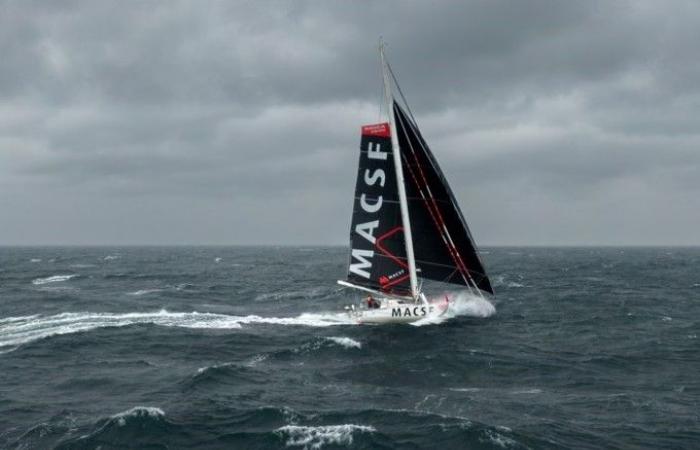With her experience in 2020, Isabelle Joschke knows the course is so demanding and the points on which she will need to be even more attentive. Bay of Biscay, Doldrums, Ecuador, Cape of Good Hope, Cape Agulhas, TAAF (French Southern and Antarctic Lands), Cape Leeuwin, Point Nemo, Cape Horn, so many mythical and feared names which will punctuate the evolution of MACSF during this world tour.
– Advertisement –
Born in Munich, Isabelle Joschke launched into the Mini Transat at the age of 27 and won the first stage during her second participation in 2007. She then went through the Figaro, the Class40, to then set up her Imoca project around diversity with MACSF . His first Vendée Globe did not go well. She had to abandon after breaking her keel cylinder. She repairs in Salvador de Bahia, and returns to sea to finish. Always supported by the MACSF, and with Alain Gautier as a mentor, she participated in all of the 2022 races alone, finishing in a good 9e place on the Route du Rhum 2022 and on the Return to Base. Determined to finish this Vendée Globe, the Franco-German sailor could well climb into the top 10.
From the Bay of Biscay to the storms of the Deep South
“The very first point of attention is the exit from the Bay of Biscay. It intervenes from the first days of the race. It is a very difficult meteorological place. The sea can be very rough, the wind quite strong, the boat suffers and hits a lot, even if this year the conditions should be rather mild. In addition there are many fishermen and cargo ships. So things can happen and we have seen in the past that there have been a whole bunch of incidents. Further south, we find the Doldrums with its violent squalls, lightning and areas of calm. It's difficult to sleep, the squalls arrive very quickly and sometimes we don't even have time to reduce the canvas. You can lose or gain places, it's not at all relaxing. »
This intertropical convergence zone, which is located north of the equator, more commonly called the Doldrums, is formidable for the nerves and sailors are wary of it, because, in the space of a few minutes, the wind can go from 0 to 35 knots. A situation which requires constant monitoring in order to adapt your sails as quickly as possible and not to be surprised. Depending on different parameters (heat of the sea and strength of the trade winds), the extent of the Doldrums can vary in size and activity.
40 days to tame the strong wind
Further south, from the latitude of the South African tip, the serious things begin.
“At the Cape of Good Hope, I am already in the South Seas and south of the 40th. When I cross it, I am almost entering the Indian Ocean which, I know, will not be easy. We cross the needle current which generates difficult seas. The presence of whales adds a great deal of risk. Overall, all the South Seas can be dangerous. The principle of navigation in these seas is to seek out depressions to go as quickly as possible. We therefore find ourselves in places where the swell is powerful and the wind is very strong. So, during the approximately 40 days that the crossing of the South Seas lasts, vigilance is almost continuous. »
Cape Horn a real deliverance?
“It’s an expected passage. It marks the exit from the Pacific. It is also the most extreme, it is located south of the 50th and touches the 60th. The wind is compressed by the continent and it is even stronger. It was a real relief but I realized that I still needed a good week of sailing to escape the cold latitudes. I experienced my biggest storm in the first part of the climb after Cape Horn. We must not believe that by starting to head towards the Northern Hemisphere, things will be simpler. »
In 2021, due to a very intense storm, Isabelle Joschke was unable to contemplate this symbolic passage. She hopes, this time, to finally discover this mythical rock.
“For me, Cape Horn is quite symbolic. 4 years ago, I crossed it about a hundred miles to the south and at night. I only realized the next day that I had passed it when I noticed the weather had changed. Suddenly, there was no more swell, the atmosphere and the sea had completely changed. There has been a big change in the way of sailing, when you leave the Pacific and find this South Atlantic area, you enter a bit of another universe.
What I dream of for this Vendée Globe is to double it during the day and in conditions that are sufficiently mild so that I can pass as close as possible to the Earth. I've seen quite a few videos of skippers passing the Cape during the day and I think there's a really special emotion. This is what I want to experience. »
South America, a very long journey back
“When you pass Cape Horn, you're super happy, it's as if, finally, you're coming out of a very long tunnel. But you're not out of trouble yet. You still have a continent to go back. From then on, my memories are a little biased, because it was very long. It took me almost three weeks to connect Cape Horn to Salvador. »
In January 2021, Isabelle Joschke was forced to abandon following a failure of her canting keel fixing system and made a technical stopover in Salvador de Bahia in Brazil. She was still able to return to sea and complete this non-racing world tour.
“On this return to the north, there is once again the Doldrums and above all, in the North Atlantic, the train of winter depressions that we must succeed in catching to return to Europe and the Bay of Biscay. I think this last crossing of the Gulf is a very important point of vigilance. »
Legitimate apprehensions
During the 2020-2021 Vendée Globe, Isabelle suffered from the cold and humidity. The IMOCA MACSF has therefore been adapted to avoid too many entries of sea and wind. Despite everything, it is certain that navigation in the Deep South will bring its share of inconveniences. In addition to these conditions, Isabelle fears two things: being obliged to dive under the hull and having to climb the mast. Exercises that she has already experimented with in order to familiarize herself with the techniques, but which she nevertheless dreads.
“In 2020, I had lots of damage, but I escaped big problems, like being forced to climb the mast or dive under the boat. If there are two things I fear, it's this. Despite some training, I'm not very comfortable in either one. » confides Isabelle.
These last days in Les Sables-d'Olonne will be focused on analyzing the weather conditions expected at the start and during the first days of the race. It is too early to be able to draw any lessons from the first files but it is certain that the weather will be at the center of the discussions.
Isabelle will leave the Port Olona pontoon on Sunday, November 10 around 8:50 a.m. to once again experience the legendary descent of the Sables-d'Olonne channel. Kick-off of this 10th edition of the Vendée Globe, the second in which Isabelle is participating, at 1:02 p.m.






